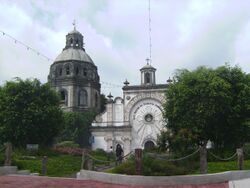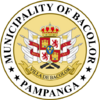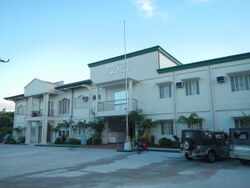Place:Bacolor
| Template:PH wikidata | |
 The half-buried San Guillermo Parish Church | |
| Etymology: Level ground | |
| Nickname(s): Athens of Pampanga | |
| Motto(s): "Non Plus Ultra"
(English: "No Further Beyond") | |
| Template:PH wikidata | |
OpenStreetMap | |
| Lua error in Module:Location_map at line 408: Malformed coordinates value. | |
| Coordinates: Template:PH wikidata | |
| Country | Philippines |
| Region | Template:PH wikidata |
| Province | Template:PH wikidata |
| District | Template:PH legislative district |
| Founded | October 8, 1762[1] |
| Barangays | Template:PH barangay count (see Barangays) |
| Government | |
| • Template:PH wikidata | Eduardo "Diman" G. Datu |
| • Vice Mayor | Ron Earvin E. Dungca |
| • Representative | Aurelio D. Gonzales Jr. |
| • Councilors | List
|
| • Electorate | Template:PH wikidata voters (electorate point in time |
| government_type = Template:PH wikidata
| government_footnotes = [2]
| elevation_m = Template:PH wikidata
| elevation_max_m = 53
| elevation_min_m = -3
| elevation_max_rank =
| elevation_min_rank =
| elevation_footnotes = Template:PH wikidata
| elevation_max_footnotes =
| elevation_min_footnotes =
| area_rank =
| area_footnotes = Template:PH area
| area_total_km2 = Template:PH wikidata
| population_footnotes = Template:PH census
| population_total = Template:PH wikidata
| population_as_of = Template:PH wikidata
| population_density_km2 = auto
| population_blank1_title = Households
| population_blank1 = Template:PH wikidata
| population_blank2_title =
| population_blank2 =
| population_demonym =
| population_rank =
| population_note =
| timezone = PST
| utc_offset = +8
| postal_code_type = ZIP code
| postal_code = Template:PH wikidata
| postal2_code_type = Template:PSGCstyle
| postal2_code = Template:PSGC detail
| area_code_type = Template:Areacodestyle
| area_code = Template:PH wikidata
| website = www
Bacolor, officially the Municipality of Bacolor (Template:Lang-pam; Template:Lang-tgl), is a 3rd class municipality in the province of Pampanga, Philippines . According to the 2020 census, it has a population of 48,066 people.Template:PH census
Bacolor is the birthplace of Father Anselmo Jorge de Fajardo, considered the "Father of Kapampangan literature"[3] for writing the 1831 Kapampangan "kumidya" Don Gonzalo de Cordova.
History
Spanish colonial era
Historical records show that Bacolor has been in existence as a proposed settlement as early as 1571, the same year Manila was founded by the Spanish. The original name of the settlement was Bakúlud, which became Hispanicized as "Bacolor" (cf. Bacolod and Bacoor). The original name is Kapampangan for "high level rocky place" or "plateau."[4]
Bacolor officially became the capital of Pampanga in 1755. According to Spanish chronicler Fray Gaspar de San Agustin, before 1755, Mexico town “es la corte de Pampanga,” while Bacolor “es la capital” and Guagua “es igualmente.” Historian Dr. Luciano Santiago theorizes that before Bacolor was formally recognized as provincial capital, it was already informally functioning as capital although other provincial administrative offices were elsewhere in Mexico and Guagua.[5]
During the British occupation of Manila, when Manila fell to the British, it became capital of the exiled government of Governor General Simón de Anda y Salazar from October 6, 1762, to May 30, 1764. The provincial offices were temporarily moved to Factoría (now San Isidro, Nueva Ecija). Through a decree of the King of Spain on November 9, 1765, Bacolor became Villa de Bacólor, one of the only three villas in the Philippines and was granted a special coat of arms. Simón de Anda organized an army of natives for the defense of Bacolor and with the aim of recapturing Manila.[6]
American invasion era
Bacolor remained the capital of Pampanga until the provincial seat of government was transferred to neighboring San Fernando in 1904. Moves to transfer the provincial capital to San Fernando actually began as early as 1852 with an expediente from the alcalde mayor. The King of Spain granted the request in a real cedula dated September 11, 1881.[7] Despite royal approval, the transfer was not executed until August 15, 1904, by virtue of Act No. 1204.[8]
The coming of the American colonizers broke up the military form of government and instead political and economic reforms were introduced. A civil form of government was organized and was inaugurated on February 13, 1901, by Com. William H. Taft which took place in the old Escuela de Artes y Oficios de Bacólor, later known as the Pampanga School of Arts and Trade and now the Don Honorio Ventura State University, the first state university in Pampanga.
The first provincial Civil Governor was Don Ceferino Joven and the first Municipal President of Bacolor was Don Estanislao Santos. Pampanga was acknowledged as the first province to have organized civil government in the Philippines by General Grant, the then President of the United States of America.
Japanese occupation era
When the Second World War broke out, Japanese fighter and bomber planes invaded the municipal town in Bacolor in December 1941 until the town was occupied by the Imperial Japanese forces in 1942. Pampangan guerrillas and Hukbalahap Communist groups joined in an insurgency centered around the municipality of Bacolor, supported by local soldiers and military officers of the Philippine Commonwealth Army. Their attacks against the Japanese occupation continued until 1945, when Filipino and American forces liberated the municipality of Bacolor. [further explanation needed]
Philippine independence
In 1956, the sitio of Mesalipit was converted into a barrio.[9]
Due to the eruption of Mount Pinatubo on June 15, 1991, the municipality was hit by lahar flows from 1991 to 1995 which buried the town by 20 feet (6.1 m), killing hundreds of people and destroying livelihood. 18 out of the 21 barangays of Bacolor were buried. The lahar from Mount Pinatubo raised the town to its current level of an approximate 37 meters above sea level. Subsidence caused the constant reclaiming of parts of Pampanga by the sea.
Geography
Bacolor is 9 kilometres (5.6 mi) from San Fernando, 26 kilometres (16 mi) from Angeles, and 75 kilometres (47 mi) from Manila.
Barangays
Bacolor is politically subdivided into 21 barangays. Each barangay consists of puroks and some have sitios.
- Balas
- Cabalantian
- Cabambangan (Poblacion)
- Cabetican
- Calibutbut
- Concepcion
- Dolores
- Duat
- Macabacle
- Magliman
- Maliwalu
- Mesalipit
- Parulog
- Potrero
- San Antonio
- San Isidro
- San Vicente
- Santa Barbara
- Santa Ines
- Talba
- Tinajero
Climate
Script error: No such module "weather box".
Demographics
In the 2020 census, the population of Bacolor, Pampanga, was 48,066 people,Template:PH census with a density of 670 inhabitants per square kilometre or 1,700 inhabitants per square mile.
Economy
Government
Local government
Like other towns in the Philippines, Bacolor is governed by a mayor and vice mayor who are elected to three-year terms. The mayor is the executive head and leads the town's departments in executing the ordinances and improving public services. The vice mayor heads a legislative council (Sangguniang Bayan) consisting of councilors from the barangays or barrios.
Town hall
The municipal building is the former site of the Venturas house, one of Bacolor's most prominent families. On July 8, 1953, the new town hall was completed during the tenure of Mayor Manuel de Jesus. Its construction was a project of Senator Pablo Ángeles y David, a native of Bacolor.[11]
Tourism
The main landmark of the town is the San Guillermo Parish Church known as the 'sunken church', one of the structures that was half-buried by the lava flow from the eruption of Mount Pinatubo in 1991. The church has since been renovated and is currently operational and may be accessed through what were once the second floor windows, now converted into doorways. The sunken church and town of Bacolor served as the main production location of the 2009–2010 ABS-CBN religious-oriented primetime television series May Bukas Pa from January 15, 2009 to February 5, 2010. The municipality also made an appearance in various films such as the 1996 movie Istokwa, 2006 movie Summer Heat and 2008 movie Jay, and in the music video of the song Promise Me by J Brothers. The Shrine of Our Lady of Lourdes in Cabetican is also famous for its annual pilgrimage and barrio fiestas.
Other notable landmarks in Bacolor include Memorial Kilometer Posts of the Bataan Death March along the MacArthur Highway; the oldest trade school in Far East, the Don Honorio Ventura Technological State University; the Simón de Anda y Salazar monument at the town hall; monument to the Kapampangan writer and revolutionary leader Juan Crisostomo Soto (1867-1918); and Monument to Felix Galura Y Napao.[12]
Bacolor's festivals are the Feast of San Guillermo and Nuestra Senora del Santissimo Rosario (La Naval) which are celebrated every 10th day of February and 3rd Sunday of November, respectively.
The Sunken Shrine
Buried by the devastating lahar flows of Mount Pinatubo eruption in June 1991, the Archdiocesan Shrine of Our Lady of Lourdes of Cabetican (abbreviated as "Maluca") remains at the center of Marian Concordia Pilgrimages and Healing in Pampanga. Originally built as an annexe to the older, smaller shrine, it is under the care of Fr. Ronnie Cao, Healing Priest and Rector of the Archdiocesan Shrine.
Notable personalities
- Mamerto Natividad, Filipino military leader
- Pablo Ángeles y David, was a Filipino magistrate and statesman. During his career, he became a judge, a member of the Philippine House of Representatives, Governor of Pampanga and a member of the Senate of the Philippines.
- Francisco Tongio Liongson, former Senator of the Philippines
- Francisco Alonso Liongson, the son of Francisco Tongio Liongson
- Pedro Tongio Liongson, Filipino lawyer and member of the Malolos Congress
- Práxedes Fajardo, Filipina revolutionary
- Jayson Castro, is a Filipino professional basketball player currently playing in the Philippine Basketball Association.
- Zoilo Galang, Filipino writer from Pampanga
- Jordan Clarkson, Filipino-American professional basketball player
References
- ↑ Baluyut, Joelyn G. (October 10, 2012). "Bacolor celebrates 250th anniversary with unveiling of statue of Spanish official". https://www.facebook.com/story.php?story_fbid=283498461769644&id=277662135686610.
- ↑ Template:DILG detail
- ↑ Santiago, Luciano (2002). Laying the Foundations: Kapampangan Pioneers in the Philippine Church, 1592-2001. Angeles City: The Juan D. Nepomuceno Center for Kapampangan Studies. ISBN 971-92417-1-3. https://books.google.com/books?id=OwxxAAAAMAAJ. Retrieved October 14, 2019.
- ↑ Forman, Michael Lawrence (2019). Kapampangan Dictionary. University of Hawaii Press. p. 20. ISBN 9780824881122.
- ↑ "Tantingco, Robby P. The Moveable Capital of Pampanga. Singsing, Vol. 4 No. 1". Center for Kapampangan Studies. https://www.hau.edu.ph/kapampangan_center/publication/pdf/singsing/a-tale-of-two-cities.pdf.
- ↑ Orejas, Tonette (18 November 2016). "Pampanga town that survived Mt. Pinatubo reclaims Spanish name and seal". Philippine Daily Inquirer. https://newsinfo.inquirer.net/845281/pampanga-town-that-survived-mt-pinatubo-reclaims-spanish-name-and-seal.
- ↑ "Henares, Ivan Anthony. 1881-1904: How San Fernando Became Capital of Pampanga. Singsing, Vol. 4 No. 1". Center for Kapampangan Studies. https://www.hau.edu.ph/kapampangan_center/publication/pdf/singsing/a-tale-of-two-cities.pdf.
- ↑ "Henares, Ivan Anthony. Timeline of San Fernando History. Singsing, Vol. 4 No. 1". Center for Kapampangan Studies. https://www.hau.edu.ph/kapampangan_center/publication/pdf/singsing/a-tale-of-two-cities.pdf.
- ↑ "An Act Creating the Barrio of Mesalipit in the Municipality of Bacolor, Province of Pampanga". LawPH.com. http://lawph.com/statutes/ra1519.html.
- ↑ "Bacolor: Average Temperatures and Rainfall". Meteoblue. https://www.meteoblue.com/en/weather/historyclimate/climatemodelled/bacolor_philippines_1729557.
- ↑ "Municipal building". Baculud.com. http://www.baculud.com/historical-sites/municipal-building/.
- ↑ "Historical sites". Baculud.com. http://www.baculud.com/historical-sites/.
External links
- Bacolor Profile at PhilAtlas.com
- [[[:Template:NSCB detail]] Philippine Standard Geographic Code]
- Philippine Census Information
- Local Governance Performance Management System
 |







